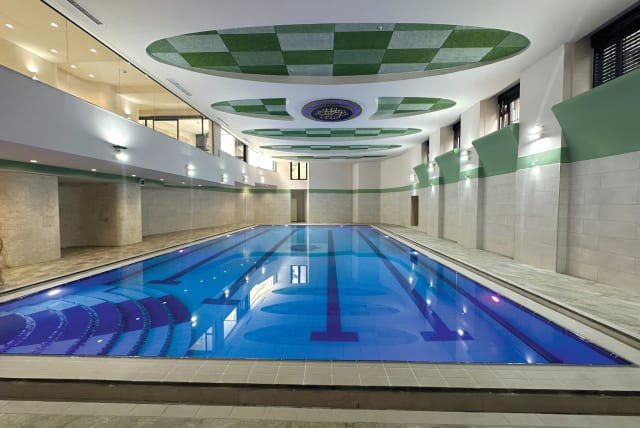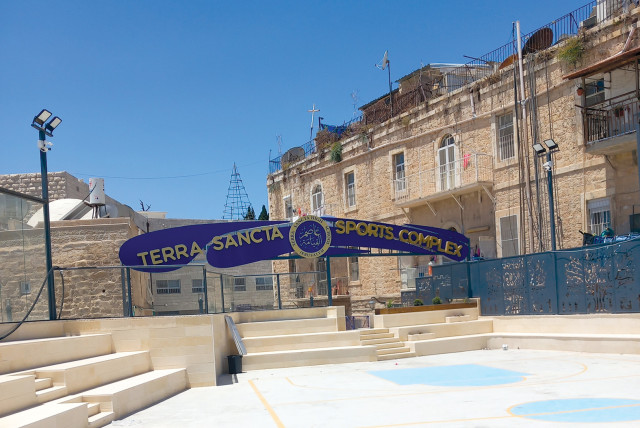Old City of Jerusalem gets its first-ever swimming pool

The sports and cultural center in the Franciscans’ St. Savior headquarters inside the New Gate is the first of its kind in the historic walled city.
After four years of excavation, archaeological preservation, extensive engineering work, and construction – and just in time for the sweltering heat wave now baking Jerusalem – an indoor swimming pool measuring 16x8 meters was inaugurated on July 3 at the Terra Sancta School in the Old City’s Christian Quarter. The sports and cultural center in the Franciscans’ St. Savior headquarters inside the New Gate is the first of its kind in the historic walled city.
Attending the festive dedication of the underground complex were Latin Patriarch of Jerusalem Pierbattista Pizzaballa (since 2020, and recently appointed a cardinal by Pope Francis); Custos of the Holy Land Fr. Francesco Patton; and representatives of the European Union, the French Development Agency, and the French Consulate – all three of which funded the project.
Why is it so difficult to build a swimming pool in Jerusalem's Old City?
Terra Sancta’s Jerusalem kindergarten-to-secondary-school campus, founded in 1645, is part of the Franciscan network of schools extending across Israel, the West Bank, Syria, Lebanon, Cyprus, Turkey, and Egypt. Enhancing the historic school’s scholastic reputation, the complex – which includes a swimming pool, sauna, multi-use rooms, and an outdoor sports field – will provide for the social and physical development of the residents of the Old City, said Fr. Vicar of the Custody of the Holy Land Ibrahim Faltas, 59, an Egyptian-born monk from Alexandria. How much did it cost to excavate four floors down and then build a swimming pool and the associated rooms?
“We spent a lot,” Faltas admitted, thanking the project architect Simon Kouha from Bethlehem, its coordinator Samir Pahdal, and the donors.
“It was a crazy idea that no one believed in. When I thought about building a swimming pool here, nobody believed me. This sports center is very important for the Old City of Jerusalem, for its young people, because it will get them away from drugs. The people of Jerusalem and their children deserve a project like this,” the monk explained.
“Anyone who has visited the Old City surely knows how impossible it is to build a swimming pool because of the narrow alleys and the proximity of housing. But the Custody of the Holy Land didn’t let that stop them. They dug down about 15 meters to allow the construction of the center.
Faltas explained how the place they chose for the pool in was “an unimaginable place.” He spoke of the “multiple difficulties and obstacles,” they faced and that sometimes they “had to dismantle the structure and rebuild it.”
“It was a nightmare,” he said, “sometimes a mix of fantasy and madness.” Excavation was not always easy. Since the area is an archaeological zone, remains of a well and a church dating back to Byzantine times were found during the work. A small museum, created inside the sports center, collects a number of artifacts.
“[Since] everyone has been affected by the pandemic, even the residents of Bethlehem who live mostly from tourism,” noted Faltas, “they worked here day and night, and that helped us get the job done.”
He spoke of the experience as akin to leafing through a history book: “Every meter, we wrote a book of anthropology, history, and geography.”
Officially called Capital of Resurrection, the center symbolizes the victory of peace over violence. “It is not humiliation, but dignity. This is Jerusalem,” he said
Faltas explained that on the foundation stone of the project, the Custody placed a well-known prayer by the founder of the order, St. Francis of Assisi: “Lord, make me an instrument of your peace.”
He pointedly noted that while officially part of a denominational school system, the swimming pool is “open to all.”
“Jews, Christians, Muslims. We don’t distinguish between people. We are all brothers.”
The pool is open daily from 8 a.m.-8 p.m. The hours will be extended if the demand is there. Faltas plans to introduce swimming lessons soon.
PREVIOUSLY, FRANCISCAN friar Faltas held the position of “discreet” of the Custody of the Holy Land from 2016-2022.
He was educated at the Franciscan School of Kafred Dawar-Alexandria. which he attended from 1969 until his graduation in 1982. Subsequently, he studied philosophy at the Franciscan Center of Christian Oriental Studies in Giza, Egypt. After completing his two-year compulsory military service in the Egyptian Army, Faltas studied from 1988 to 1992 at Jerusalem’s Studium Teologicum Jerosolytanum, obtaining a Baccalaureate (bachelor’s degree) in theology.
Ordained a priest in the Order of Friars Minor – Custody of the Holy Land, he served as director of the Headnurse School in Jericho, 1993-1995. Since then, he has been director of the College of the Holy Land in Bethlehem, as well as responsible for the Status Quo (of the Holy Places) in the Basilica of the Nativity in Bethlehem.
Faltas is intimately aware of the conflict between Israelis and Palestinians. During the armed siege of the Basilica of the Nativity in Bethlehem in 2002, he served as a mediator between the Palestinian gunmen and the IDF. That experience led him to write the Italian-language book The Siege of the Basilica of the Nativity. ❖
Jerusalem Post Store
`; document.getElementById("linkPremium").innerHTML = cont; var divWithLink = document.getElementById("premium-link"); if (divWithLink !== null && divWithLink !== 'undefined') { divWithLink.style.border = "solid 1px #cb0f3e"; divWithLink.style.textAlign = "center"; divWithLink.style.marginBottom = "15px"; divWithLink.style.marginTop = "15px"; divWithLink.style.width = "100%"; divWithLink.style.backgroundColor = "#122952"; divWithLink.style.color = "#ffffff"; divWithLink.style.lineHeight = "1.5"; } } (function (v, i) { });


